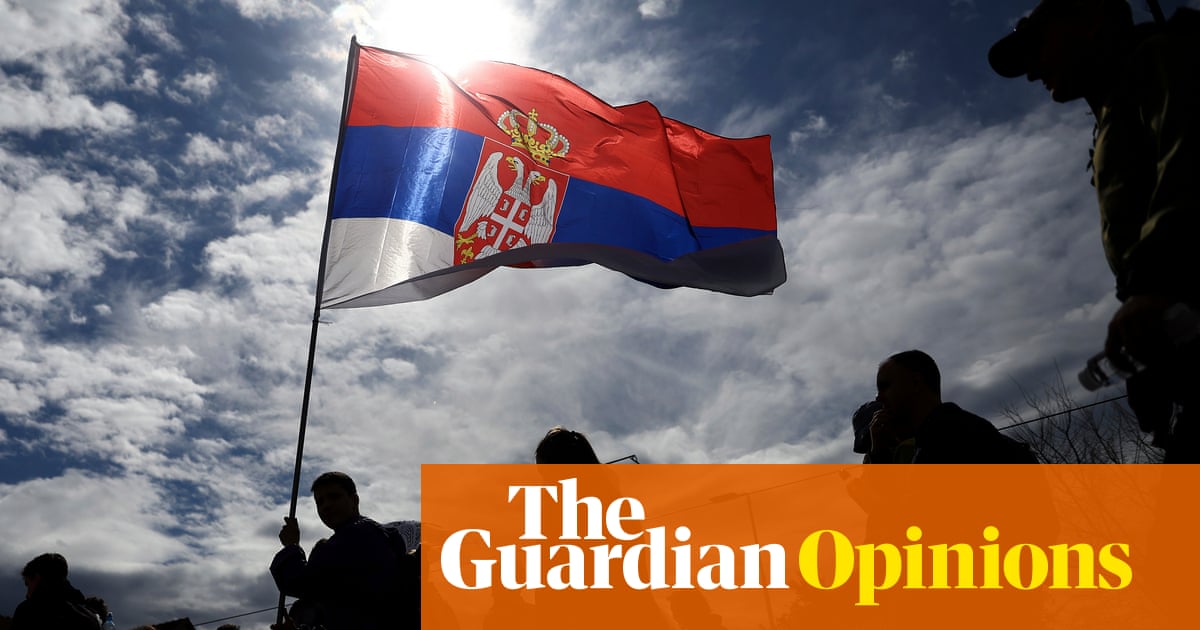Photo credit: www.theguardian.com
In Belgrade, growing dissent against President Aleksandar Vučić’s longstanding authoritarian regime has become increasingly visible. Following several months of predominantly peaceful protests led by students, many citizens are expressing their frustration, suggesting that the tipping point has been reached.
Anticipation is building for a significant anti-government demonstration, as thousands of students and other citizens prepare to assemble against the Serbian government. Many locals describe the atmosphere in the capital as feeling like it is “under siege,” with authorities employing drastic measures that critics argue are aimed at intimidating citizens and impeding attendance at the protest.
The state railway operator, Srbijavoz, has unexpectedly canceled all inter-city train services, attributing the decision to anonymous bomb threats. Reports also indicate cancellations of inter-city bus services to Belgrade, as well as rumors of farm machinery being used to obstruct key access routes into the city. These extraordinary actions have drawn criticism, as many believe the government is effectively enclosing Belgrade to stifle the protest.
Nevertheless, numerous groups of students and supporters from various regions of Serbia are determined to find alternative routes to Belgrade. Many have begun their journey days in advance, using bicycles or traveling on foot, motivated by their desire to participate in what could potentially be a historic demonstration.
Simultaneously, Western diplomats are advising Serbia’s leaders to ensure the protest is peaceful and to protect the safety of participants, cautioning that any attempt to repress demonstrations could heighten tensions within the country and in the international arena.
Contrasting with calls for tranquility from diplomats, Vučić’s administration portrays the upcoming rally as a potentially explosive situation. Officials have been consistently issuing warnings of imminent clashes, implying that protestors could become violent or attempt to storm Parliament.
Such alarmist statements are being used to justify a heavy-handed approach, with a significant police presence and proactive security measures established around Belgrade. These actions not only exacerbate the prevailing tensions but also convey a clear message of intimidation, framing the protestors as threats to national stability while reinforcing the government’s narrative of authority.
The catalyst for this unrest can be traced back to a tragic incident late last year, when a concrete canopy collapsed at the main railway station in Novi Sad, claiming 15 lives. This disaster initiated widespread protests over deeper issues, symbolizing ingrained problems within a system characterized by corruption, inefficiency, and political favoritism.
Although allegations of corruption are rampant, substantiating these claims is often challenging. Critics cite non-transparent government contracts, political patronage, and a lack of accountability as significant concerns. Moreover, the judiciary is seen as compromised, the media faces constant threats, and civil society operates under duress. In this context, protests have evolved beyond specific issues to represent a broader demand for liberation from autocratic control.
The eruption of student activism is indicative of a generation that perceives itself as neglected by a long-dominant political elite. This movement represents an unprecedented wave of opposition, significantly amplified through social media, which is extending its reach beyond urban centers into Serbia’s towns and villages.
The persistence and scale of these protests indicate a pivotal moment for the country, as Vučić, once viewed as unassailable, encounters a formidable challenge to his power. Yet, in the face of widespread discontent, Western nations continue to engage with the controversial leader, prioritizing Serbia’s status on the “EU path.”
While critiques of Vučić’s administration abound, there is a notable absence of a strong alternative should his regime falter, as the political opposition remains fragmented and often mired in internal disputes rather than presenting a unified vision for the future.
Moreover, the EU’s willingness to negotiate with Vučić raises concerns about its commitment to democratic values and strategic interests within the region. This relationship overlooks serious issues, including Vučić’s connections with Vladimir Putin, the growing Chinese influence on Serbian infrastructure, and the continued majority ownership of Serbia’s energy giant, NIS, by Russian entities, despite EU sanctions.
This dichotomy in EU policy prompts questions about the bloc’s dedication to its core principles versus its pragmatic approach to regional stability.
Within Serbia, government-imposed lockdown tactics contribute to a climate of impending unrest, while protesters, buoyed by international support, maintain their commitment to peaceful demonstration.
The sentiment among many in Belgrade is that the planned demonstration will unfold without violence, countering foreboding predictions. However, the situation remains volatile, and the response of authorities will be critical in determining whether the right to assemble peacefully is honored.
As Serbia endeavors to navigate its complicated relationship with Moscow while aspiring towards EU and NATO membership, it raises further inquiries about the leadership’s long-term priorities. Under Vučić, the nation has exhibited increasing authoritarianism, which amplifies skepticism regarding his genuine intentions for the future. As history indicates, ignoring the complexities of the Balkans may yield unpredictable and significant repercussions.
Source
www.theguardian.com

